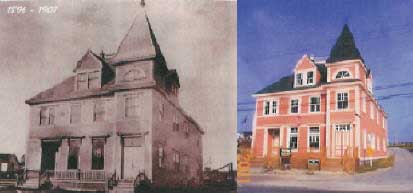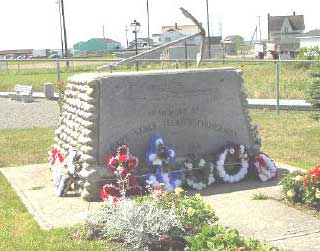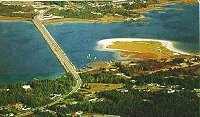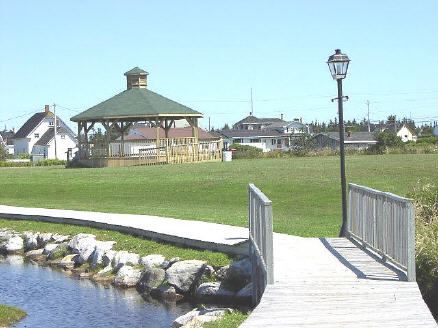History
Industries
Media
Staff
Town Business
Accessibility
Plan
Election Info
Expense Reports
Public Hearings
Spring/Fall Cleanup
Tax Exemptions
Town Minutes
Election Info
Expense Reports
Public Hearings
Spring/Fall Cleanup
Tax Exemptions
Town Minutes
Tourism
Town of Clark's Harbour : Sights
When you visit Clark's Harbour and the surrounding area, you will be able to see many wonderful things. Here are just some of the interesting sights you will find as you enjoy the area.The Lion & one of the Dog sculptures


The Lion monument is located behind the Town Hall.
This monument was scheduled to stand guard in front of an old house in 1906. Its creator was a sixteen year old boy named John Wilmot Nickerson who produced it out of cement and clay. John's uncle, J. Lendall Nickerson, owned the Sea View Hotel next door. Using his uncles dog as a model, John also made two statues which were placed on each side of the hotel's entrance. Unfortunately, the weather took its toll and the dogs were removed.
John was an exceptional artists and need to leave the sheltered island so his true talent could be admired by the world. He ended up moving to Fresno, California to pursue his dreams. There, he received the recognition he deserved and opened his own shop in Glendale, California. He became a leading sculptor and was known for his last creation, a complete sculpture of The Last Supper.
The Stone Church


The Stone Church was first started on September 5, 1921, by Lieutenant-Governor Grant. The foundation is made of native granite and three feet in thickness. The granite that was used was all cut by hand using chisels. The walls are made of cobble stones gathered from the shore and surrounding islands. This church is 85' by 55' and has a seating capacity of five hundred. The inside of the church is decorated in rich wood and is very beautiful. The woodwork covering the walls is fitted with tongue and groove.
All of the windows were stained glass and were brought from Toronto in 1927. These beautiful windows were all inscribed as memorials by families or individuals at a considerable amount of money for that time.
Mr. Thomas Doucette was given the task of constructing the Stone Church from blueprints which were designed by a Halifax architect named S. P. Dumaresq. Thomas Doucette began building the church, even though he could not read or write, and had the blueprints read to him only once. It took ten years to totally complete the church.
The Seaside Heritage Center

The Seaside Heritage Center building is once again enjoying its place of prominence within the Town. Located at 2773 Main Street, it is open to the public during the months of June to September of each year.
The history of the area developed in and around the sea, the island being adjacent to the richest fishing grounds left in Canada.
The building cornerstone was laid in 1895 and was constructed by local boat builders. The building was commissioned by the Independent Order of Oddfellows and consists of three levels. The building was purchased by the Town of Clark's Harbour, renovated, refurbished, and opened to the public in 2000.
The first floor of the building interprets the lifestyle, history, and culture of the area. Cape Sable Island is renowned for the building of the Cape Sable Island boats. These boats are still considered the "work horse" of the fishing industry and continue to be bulit on the island. The Center has on exhibit one of the first models of this type of boat (circa 1930-1940s). It is built to half scale and was constructed by one of the best known boat builders of the area - Freebert Atkinson. The boat has many unique features and is definitely a "must see" when visiting the center.
Other exhibits showcase the lighthouses and shipwrecks of the area. Each day, artisans, local storytellers, and crafts related to the fishing industry are demonstrated.
Tour groups are welcome. Please call in advance to arrange times and costs.
Phone: 902-745-0844 (June to September) or 745-2390
Fax: 902-745-0918 (June to September)
The Fisherman's Memorial

In 1983, a monument was sculpted to remember all who were lost at sea. It now resides beside the Western Counties Regional Library. Every year, a memorial service is held where everyone can come and remember those who are lost, but not forgotten.
The Soldier's Memorial

In 1921, the Town of Clark's Harbour decided to create a monument to honor the boys of the 219 Regiment who were lost in World War I. The unveiling took place on November 11, 1922, in front of the well-known Stone Church. This monument was created out of granite. Three pieces make up the base and a fourth piece is where the inscriptions were carved. A seven-foot, bronze soldier stands tall above these slabs, in uniform, wearing a rifle, and standing at ease.
This monument still stands in front of the church for everyone to look at and remember our loved ones who risked their lives for our freedom.
Cape Sable Lighthouse

The Cape Sable Lighthouse is located a short distance from the town of Clark's Harbour, on the island of Cape Sable, which is off the end of The Hawk. The Hawk is the most southern tip of Cape Sable Island, which makes this spot ideal for a lighthouse.
The first lighthouse was constructed in 1861 by John MacKinnon, due to a ship wreck off the ledge of Cape Sable Island. On Februrary 19, 1860, the ship, the Hungarian, did not have any warning and struck the treacherous ledge. Everyone aboard was lost.
The lighthouse was lit for the first time on November 12, 1861. The light was a fixed red beacon, which was manned by John H. Doane. In 1923-1924 the old wooden lighthouse was replaced with a concrete tower which would withstand the weather and elements more sufficiently. It was manned for many years but was changed over to automation in recent years.
The Causeway

The talk of a causeway all began in 1945 when the provincial government started surveys in June of 1946. Premier Angus L. MacDonald announced an appropriation of $400,000 for its construction. On August 29, 1948 the first load of rocks were dumped and the construction began. It was thought that, because of the strong tides, the work would be long and difficult; however, with the use of modern machinery, the fill was made much sooner than expected and, on April 29, 1949, the North East Point shore was reached. On Sunday, May 1, 1949, over one hundred cars crossed the 3100 foot causeway, which had been built at a cost of approximately $600,000.
The official opening of the Causeway on August 5, 1949 was a warm and sunny day as hundreds of people gathered for the ceremony. Premier Angus L. MacDonald delivered the main address and cut a white ribbon to symbolize the beginning of a new era of travel to the island. The stretch of water, known as Barrington Passage, is no more, and instead there is Barrington Bay on the eastern side of the Causeway and on the western side, a bay which is, as yet, officially unnamed. On August 5, 1999, the Causeway celebrated its 50th year and is still holding its keep in Shelburne County as a useful way of transportation to and from the island.







